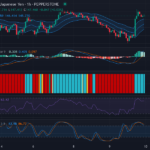
Bullish Momentum Climbs for the US Dollar Against the Japanese Yen Despite Overbought Cautions – 10/04/2025
Tháng 4 9, 2025
Republicans Block Vote on Trump’s Tariffs: A Power Play Amid Trade Turmoil
Tháng 4 10, 2025Understanding Japan’s Economic Landscape: Key Insights from Recent Data
Japan’s economy is currently at a critical juncture, shaped significantly by the latest economic indicators. The recent data release offers a dual narrative of rising producer prices against a backdrop of declining consumer confidence. This blog post delves deeply into the implications of these trends, providing valuable insights for investors, policymakers, and economists.
Rising Producer Prices and Their Implications
Producer Price Index (PPI) serves as a key indicator of inflationary pressure within the economy. In March, Japan’s PPI surged by 0.4% month-over-month and an impressive 4.2% year-over-year. This notable increase not only surpassed market expectations of a 0.2% monthly rise and 3.9% year-over-year but also raised important questions about future inflation trends.
The growth in producer prices could significantly influence inflation expectations and potentially prompt the Bank of Japan (BOJ) to re-evaluate its monetary policy framework. As prices for raw materials and intermediate goods continue to climb, companies may pass these costs onto consumers, leading to heightened inflationary pressures. Observers will be closely monitoring the BOJ’s response, particularly as it navigates a landscape marked by both economic recovery and inflationary challenges.
Declining Consumer Confidence: A Cautionary Tale
In stark contrast to the bullish PPI data, Japan’s consumer confidence index faced a decline, dropping to 34.1 in March. This marks the fourth consecutive month of diminishing consumer sentiment, reaching its lowest point since March 2023. While this decline in confidence reflects broader economic uncertainties, the slight uptick in the willingness to purchase durable goods offers a glimmer of optimism.
Despite the general pessimism, consumers’ readiness to invest in long-lasting items suggests they may have faith in future economic improvements. This duality in consumer behavior highlights the complexities of the Japanese market, where optimism in one area can coexist with caution in another.
The Broader Economic Context
Analyzing Japan’s market dynamics, one finds that the country trades at a price-to-book ratio of 1.4x. This positioning is relatively favorable when compared to many global equities, hinting at potential investment opportunities. For investors and analysts, this could indicate that Japanese equities are relatively undervalued. For additional insights into value investing strategies, consider reading about 3 reasons Greenblatt says value investing beats the market. However, a careful assessment of the continuing shifts in consumer confidence and market sentiment is essential in guiding investment strategies.
Global Trade and Its Indirect Effects
Moreover, Japan’s economy may face indirect repercussions due to significant global trade tensions, especially between the U.S. and China. Increased tariffs and shifting trade relations can create uncertainty, which often translates to fluctuations in currency valuations and trade volumes. Given Japan’s reliance on exports, particularly in high-tech manufacturing and automotive sectors, global trade dynamics could lead to both opportunities and challenges. For a deeper understanding of how such trade strategies might impact economic relationships, you can explore three strategic moves by China under Xi.
In summary, Japan’s recent economic data paints a complex picture. The PPI’s rise suggests potential inflationary trends, while declining consumer confidence raises flags about immediate domestic demand. As global trade positions shift, the Bank of Japan’s monetary policy adjustments will be critical in supporting economic growth and managing inflation expectations. Stakeholders should remain vigilant, adapting to the changing economic landscape as they navigate these intertwined factors. To avoid common pitfalls in investment strategies during uncertain times, check out the list of top investment mistakes to avoid in 2023.
